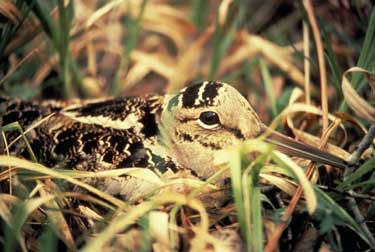Somewhere in either Tolstoy or Dostoevsky there is a comment about the remorse of the hunter when holding a Woodcock in hand. You have noticed that our head image on Maggie's now is Woodcock hunting.
Skinner's charming section on the Woodcock, written back before hunting seasons were instituted, is here.
 The Woodcock is a fat little shorebird, fatter but not much larger than the American Robin, who renounced the shore and took up residence in our Eastern woods and swamps.
The Woodcock is a fat little shorebird, fatter but not much larger than the American Robin, who renounced the shore and took up residence in our Eastern woods and swamps.
Like all shore birds, they are ground-dwellers and ground nesters, and do not perch. Because of their camoflage, their habit of feeding and being active at dawn and dusk, and their trick of freezing when approached, they are not commonly seen except in early spring, when the males perform their remarkable aerial mating dance at dusk.
Their long bills are hinged near the tip for capturing earthworms which they probe for in the soil and forest litter. They are thus necessarily migratory, to the Southern US.
A few other details: Woodock is the only "shorebird" which is a legal game bird in the US today. They are not widely hunted, but they make excellent sport and their liver-flavored breasts are a rare gourmet treat. The French especially favor the brains, on toothpicks. People who don't like to eat them should not hunt them. Their habitat overlap with the Ruffed Grouse makes a typical mixed bag for Ruffie hunters. Because of their small size and cute appearance, many hunters will admit a mingled sense of dismay and pleasure when they bag a Woodcock. Unlike grouse, they cannot be hunted without dogs, because you would never find them. A decline in Woodcock numbers has been noted over recent decades, which may be due to habitat loss, but the cause is not certain. They are fond of overgrown fields and orchards, wetland edges, and transitional young woodlands, especially birch and aspen. The European Woodcock looks like ours, but is larger. Woodcock's heads are oddly-arranged: their brains are upside-down, and their ears are in front of their huge eyes.
More about the Woodcock here. The Ruffed Grouse Society supports research on Woodcock along with grouse.


 The Woodcock is a fat little shorebird, fatter but not much larger than the American Robin, who renounced the shore and took up residence in our Eastern woods and swamps.
The Woodcock is a fat little shorebird, fatter but not much larger than the American Robin, who renounced the shore and took up residence in our Eastern woods and swamps.